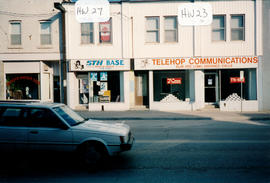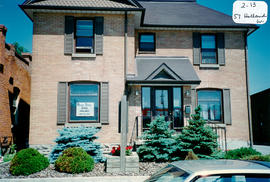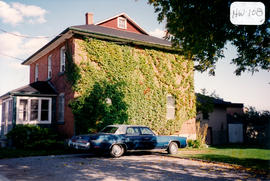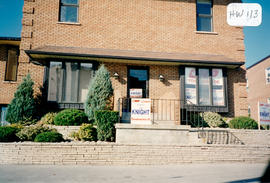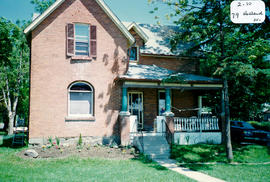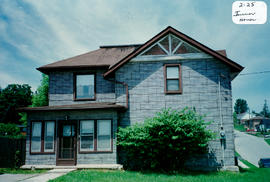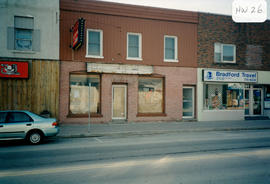10 and 12 Holland Street West - Compton's IGA
- CA BWGPL GJ-HB-2017-03-28-03
- Unidad documental simple
- 1995
Parte deGeorge Jackson fonds
The mid-block building located at 10 and 12 Holland St. West was built in the Ontario Vernacular style around 1872-1899. The two-storey, commercial, detached ‘row’ building had a narrow rectangular plan with an asymmetrical organization. ‘Main street’ frontage with a typical storefront façade was located at the street line. The plain façade was characterized by a high, flat, ‘boomtown’ façade and cornice with brick dentils. The two bay-façade each had its own entrance and storefront. Existing doors and storefronts are not original. The original, large, second-floor windows (characterized by segmented arch openings and concrete sills) have been partially bricked in, but are still visible from the brick voussoirs. The building has masonry construction with brick cladding and a flat, built-up tar and gravel roof. (1, 3)
The west side of the building (10 Holland St. West and the location of Pizzaville in this 1995 photo) was once the site of a drugstore run by W.L. "Billie" Campbell. Fred Cook helped him for a number of years. Billie’s son, Lou, and druggist Clarence Ritchie took over the business. Eventually Clarence Ritchie ran it on his own before he retired. Fred McKay sold phonographs on the upper floor and there was a pool room run by James Ferguson. The Salvation Army held services here in the 1930’s. (1, 2)
Sutherland’s Grocery Store was once found at 12 Holland St. West (site of Karen’s and Tina’s Flowers in this 1995 photo). Alec Sutherland was a baker. He had a bakeshop on the south side of Simcoe St. that was run for many years by his daughter Jessie and sister Mrs. Bessie Ryan (and her daughter Betty). They eventually retired and moved to St. Catherine’s. There were living quarters upstairs. William Compton and his wife bought the store and ran it as an IGA grocery store. Gord and Marilyn Compton later took over the store. They built a new store on John St. (where Frank Kilkenny’s house had been). The Comptons’ store eventually moved to what was known as the IGA plaza (located at the corner of Collings Ave. and Holland St. West). As of 2014, 12 Holland St. West is the site of The Holland Bloom florist shop. (1, 2)
Sin título


